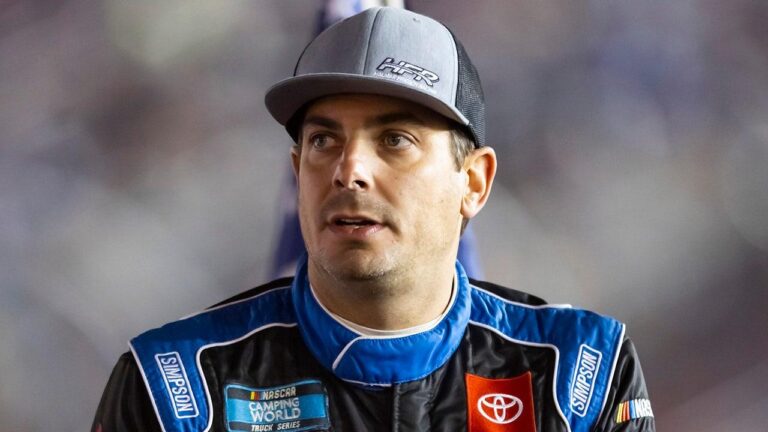Stewart Friesen suffered significant injuries, including fractures to his pelvis and leg, following a crash during a dirt modified race in Canada, NASCAR.com has confirmed. The incident occurred amid intense competition, raising concerns about the driver’s recovery and future in racing. Details of the accident and Friesen’s condition are emerging as officials and medical personnel continue to assess the situation.
Stewart Friesen Suffers Serious Injuries in Canadian Dirt Modified Crash
Stewart Friesen, a prominent figure in dirt modified racing and NASCAR circuits, encountered a severe crash during a race event in Canada that left him with multiple fractures, including serious injuries to his pelvis and leg. The incident occurred in high-speed conditions on the challenging Canadian dirt tracks, where Friesen was competing fiercely. Emergency crews responded promptly, ensuring his safe extraction and immediate hospitalization.
Initial reports from medical officials indicate that Friesen will undergo surgery followed by an extensive rehabilitation period. His racing schedule has been put on hold as his medical team focuses on recovery. Fans and fellow drivers have expressed widespread support. Below is a summary of his injuries and current status:
| Injury | Severity | Recovery Time (Estimated) |
|---|---|---|
| Pelvic Fracture | Severe | 3-6 months |
| Leg Fracture | Severe | 4-7 months |
| Additional Bruising | Moderate | 2-4 weeks |
- Immediate Surgery: Confirmed to stabilize fractures.
- Rehabilitation Protocol: Customized physical therapy plan post-surgery.
- Racing Impact: Uncertain return date to NASCAR competition.
Analysis of Crash Impact and Safety Measures in Dirt Track Racing
The recent accident involving Stewart Friesen during the dirt modified race in Canada serves as a stark reminder of the high-risk nature of dirt track racing. The sheer forces generated during these crashes can subject drivers to extreme physical trauma, as evidenced by Friesen’s fractured pelvis and leg. Despite advances in vehicle design and safety protocols, the unpredictable terrain and close-quarter racing conditions on dirt tracks continue to challenge both drivers and safety teams. The impact forces in dirt track crashes often involve rapid lateral movements and rollovers, making traditional safety equipment essential but sometimes insufficient without extensive track safety measures.
In response to incidents like Friesen’s, several key safety measures are increasingly prioritized across the dirt racing community:
- Enhanced roll cages: Constructed from reinforced steel tubing designed to withstand intense impacts and prevent cockpit intrusion.
- Advanced seat restraints: These systems, including multi-point harnesses, keep drivers securely locked while reducing injury risks during sudden decelerations.
- Track safety improvements: Implementation of energy-absorbing barriers and consistent surface grading to minimize crash severity.
- Emergency medical protocols: On-site rapid response teams trained specifically in motorsport trauma care.
| Safety Feature | Purpose | Effectiveness |
|---|---|---|
| Roll Cage | Protect driver from impact intrusion | High |
| Seat Restraints | Reduce injury during sudden stops | High |
| Energy-Absorbing Barriers | Minimize crash impact forces | Medium |
| Medical Teams | Rapid emergency response | High |
Recommendations for Enhanced Protection in High-Risk Motorsport Events
To mitigate injuries such as those sustained by Stewart Friesen, implementing advanced protective measures is paramount. Enhancements in helmet technology and reinforced neck support systems play a crucial role in absorbing and distributing impact forces during high-speed collisions. Additionally, the integration of energy-absorbing barriers around dirt tracks can reduce the severity of crashes by dampening the initial impact. Teams and regulatory bodies must also prioritize regular safety audits of vehicles to ensure that roll cages, harnesses, and seats meet evolving safety standards, specifically designed to withstand the unique stresses of dirt track racing.
Besides mechanical improvements, educating drivers on situational awareness and crash avoidance techniques is essential for reducing accident frequency and severity. Event organizers should enforce stricter protocols regarding track conditions and visibility, especially under adverse weather or lighting. The following table illustrates a recommended safety upgrade matrix for high-risk motorsport disciplines, emphasizing actionable improvements:
| Safety Upgrade | Benefit | Priority |
|---|---|---|
| Advanced Helmet Padding | Improved impact absorption | High |
| Reinforced Neck Restraints | Reduced risk of spinal injuries | High |
| Energy-Absorbing Barriers | Minimized collision forces | Medium |
| Driver Safety Training | Enhanced crash prevention | Medium |
| Track Condition Monitoring | Optimized race-day safety | High |
To Conclude
Stewart Friesen’s crash during the dirt modified event in Canada marks a significant setback for the driver as he begins his recovery from serious injuries including a fractured pelvis and leg. NASCAR and the racing community have extended their support, wishing him a swift and full recuperation. Further updates on Friesen’s condition and his racing schedule will be closely monitored as he works through his rehabilitation.




